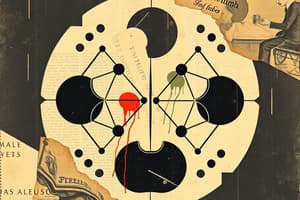Podcast
Questions and Answers
Explain why a cell's volume increasing faster than its surface area poses a challenge.
Explain why a cell's volume increasing faster than its surface area poses a challenge.
As a cell grows, the ratio of surface area to volume decreases, making it difficult for the cell to efficiently transport nutrients in and waste products out. This limitation hinders the cell's ability to sustain itself.
Describe the critical event that must occur before a cell can divide during mitosis and in which phase does it occur?
Describe the critical event that must occur before a cell can divide during mitosis and in which phase does it occur?
The critical event that must occur before a cell divides during mitosis is the copying of DNA, or chromosome duplication. This occurs during the S phase (synthesis phase) of the cell cycle.
During which phase of mitosis do sister chromatids separate and move toward opposite poles of the cell?
During which phase of mitosis do sister chromatids separate and move toward opposite poles of the cell?
Sister chromatids separate and move toward opposite poles of the cell during anaphase.
Describe the role of the centromere during cell division.
Describe the role of the centromere during cell division.
How does cytokinesis differ from mitosis?
How does cytokinesis differ from mitosis?
Explain how cell specialization contributes to the overall function of a multicellular organism.
Explain how cell specialization contributes to the overall function of a multicellular organism.
Describe the primary function of neurons and how their structure supports this function.
Describe the primary function of neurons and how their structure supports this function.
Arrange the following terms in order from smallest to largest: organ, cell, organ system, tissue.
Arrange the following terms in order from smallest to largest: organ, cell, organ system, tissue.
What is the role of cyclin in the cell cycle, and what happens to cyclin levels during mitosis?
What is the role of cyclin in the cell cycle, and what happens to cyclin levels during mitosis?
How do cancer cells differ from normal cells in terms of their response to cell cycle signals?
How do cancer cells differ from normal cells in terms of their response to cell cycle signals?
Flashcards
Cell Growth Limitations
Cell Growth Limitations
Cells can only grow so large due to volume/surface area constraints; larger cells struggle with nutrient intake and waste removal.
Cell Cycle
Cell Cycle
The duration from one cell division to the next; varies between different cells, average in human adults is 20 hours.
Mitosis
Mitosis
The process where a cell divides into two independent daughter cells; involves duplication of DNA before division.
Interphase
Interphase
Signup and view all the flashcards
Prophase
Prophase
Signup and view all the flashcards
Metaphase
Metaphase
Signup and view all the flashcards
Anaphase
Anaphase
Signup and view all the flashcards
Telophase
Telophase
Signup and view all the flashcards
Cell Specialization
Cell Specialization
Signup and view all the flashcards
Cyclin
Cyclin
Signup and view all the flashcards
Study Notes
Cell Growth and Division
- Cell size is limited; volume increases faster than surface area, hindering nutrient intake and waste removal.
- Large cells struggle to support their needs.
- The cell cycle describes the time from one cell division to the next.
- Cell division rates vary by cell type.
- Errors in the cell cycle can be serious, like cancer.
Cell Cycle Stages
-
Interphase: The period between cell divisions, composed of:
- G1 phase: Cell growth.
- S phase: DNA replication (chromosome duplication).
- G2 phase: Preparation for mitosis.
-
Mitosis (M phase): Cell division into two daughter cells.
- Includes four key phases: prophase, metaphase, anaphase, and telophase.
Mitosis Phases
- Prophase: Longest phase, chromosomes condense, and spindle fibers form.
- Chromatin condenses into visible chromosomes.
- Each chromosome consists of two identical sister chromatids joined at the centromere.
- Centrioles move to opposite poles, forming spindle fibers.
- Metaphase: Shortest phase, chromosomes align at the cell's equator.
- Anaphase: Centromeres divide, sister chromatids separate and move to opposite poles.
- Telophase: Chromosomes decondense, new nuclear membranes form around each set of chromosomes. Cytokinesis begins.
Cytokinesis
- Cytoplasm divides, forming two separate daughter cells.
Cell Specialization
- Specialized cells perform specific functions.
- Four major types: nerve, epithelial, muscle, and connective.
- Examples:
- Macrophage: Immune cell, fights infection.
- Neuron: Nerve cell, transmits signals.
Cellular Organization
- Cells → Tissues → Organs → Organ Systems.
- Organisms (both large and small) share this basic structure.
Cell Cycle Control
- Cyclins are proteins that regulate the cell cycle by triggering certain steps.
- Insufficient cyclin prevents DNA replication during the cell cycle.
- Cancer cells lack normal cell cycle controls, leading to uncontrolled growth.
Studying That Suits You
Use AI to generate personalized quizzes and flashcards to suit your learning preferences.




